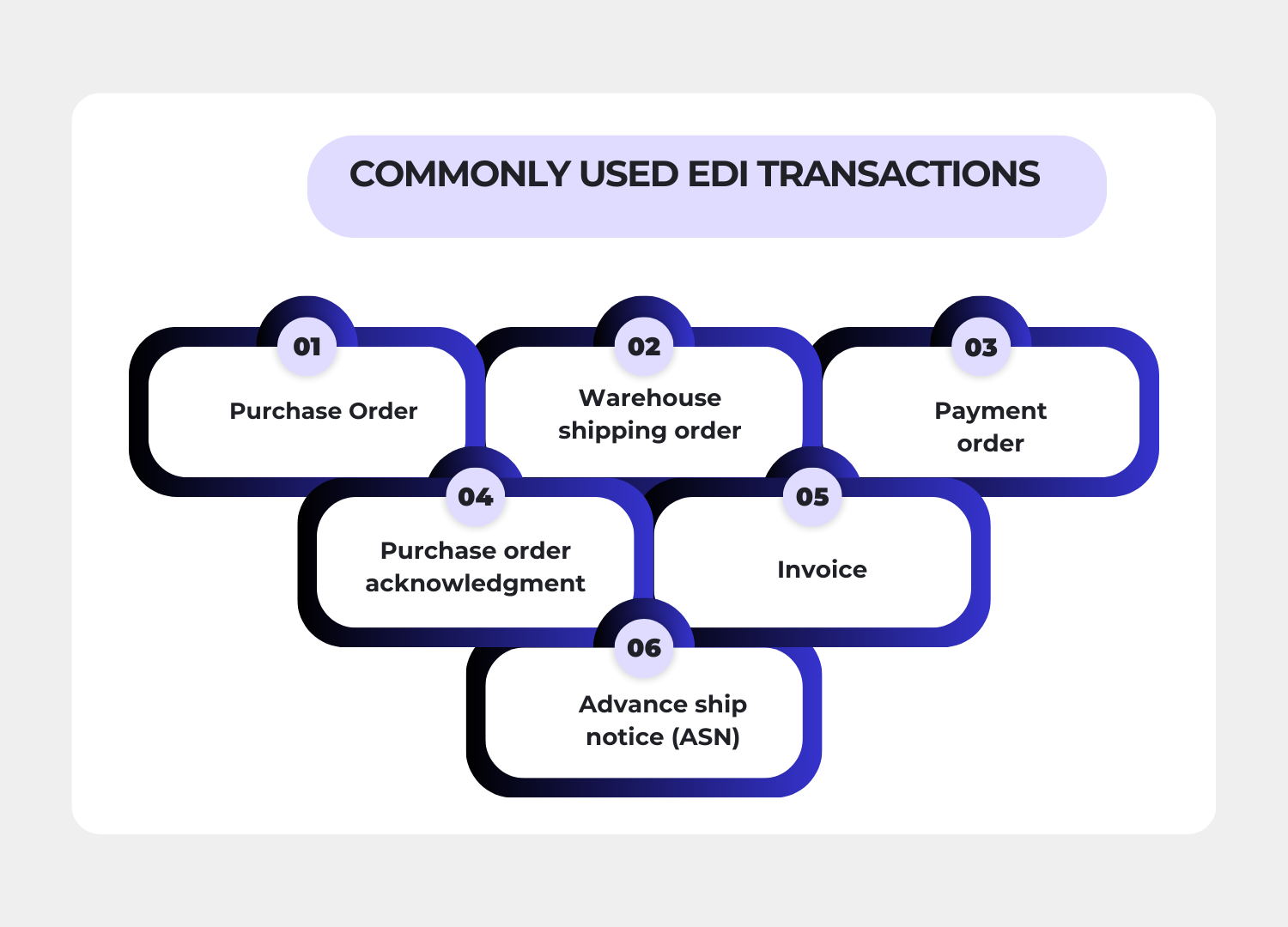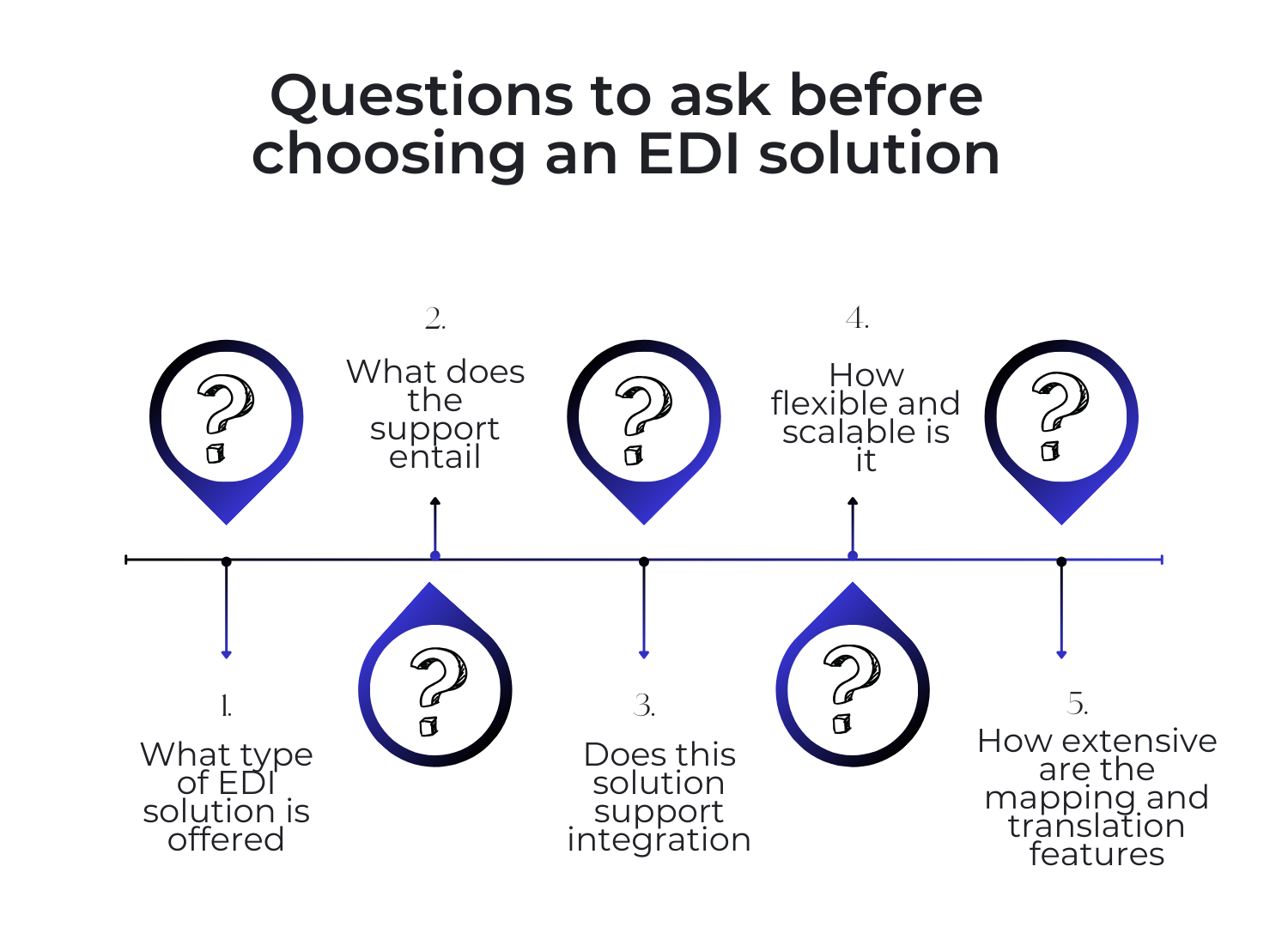Table of Contents
Businesses of all sizes are concerned about operational efficiency. Using technologies like EDI, organizations can streamline processes and automate correspondence. Then, what is EDI? What else is it capable of? The standard computer-to-computer transfer of information between two or more partner companies is known as electronic data interchange or EDI. It is a technique for sending data digitally between businesses and their partners, clients, and systems. One tool that the computer uses to facilitate data transfers with other computers is EDI platform. The data is prepared by the program through translation into the common EDI format.
The fields of manufacturing, retail, healthcare, finance, and logistics frequently use EDI services. EDI helps with sending documents, including purchase orders, shipment notices, and invoices. It’s also frequently utilized to simplify financial and HR procedures. For instance, major merchants who purchase from manufacturers and suppliers require an EDI connection because they depend on the precision and smoothness of the process to ensure consistent shipments of products to keep their shelves stocked. When dealing with several manufacturers and suppliers, EDI automation might mean the difference between success and failure.
In addition to being far quicker than traditional communication channels like fax and mail, EDI is also far more secure because it requires very little to no human involvement. The average small retailer in the United States has only 63% inventory accuracy without EDI in small businesses. Continue reading to learn about the many types of EDI services, their functions, and the benefits they can offer your company.
EDI: What is it?
Electronic data interchange, or EDI for short, is also called data exchange. Manufacturers can communicate business papers and a range of transactional information with their suppliers, vendors, and brands through the combination of computer systems and processes. It uses an electronic format that can integrate into any number of communication channels to establish organization, structure, and flow of critical information that needs to be divided into these different groups or destinations. As web-based solutions have become more and more popular in recent years, enabling low-cost data transfer over the Internet, VAN providers have started to offer additional services as part of their “value-add” packages, including EDI data, encryption, management reporting, and secure email.
When business papers are shared between manufacturers and their counterparts, EDI solutions serve to increase the speed and accuracy of those documents. By using EDI automation, paper papers can be eliminated while also ensuring that no data, including orders and transactions, is lost in the process. Expensive human data entry errors that frequently accompany the painstaking and comprehensive information processing required for logistics are minimized, as are the costs of manual data input and document exchange (and the time that takes!). Additionally, EDI solutions can offer a crucial line of defense against fraud and documentation mistakes that could negatively impact a manufacturer’s profitability.
A retailer can use EDI transactions to send their purchase orders digitally to their manufacturers. This is a faster and more automated manner than emailing, faxing, or mailing paper documents. This is one way that a manufacturer (brand) can collaborate with a retailer (also known as a Trading Partner). Retailers can electronically transmit their invoices and transactional documents to manufacturers by using EDI documents, which facilitate the effective flow of information back to the manufacturer.
Solve Your EDI Challenges With Our Custom EDI Solutions
How does EDI work?
The process of sending data through EDI, such as an invoice or purchase order, is automated and well-defined. This is how it operates:
- Document production and translation: Using an EDI solution or translation software, a business must first translate or convert any new documents—such as purchase orders, invoices, or other documents—into standard EDI documents.
- EDI transmission: After translation, there are two main ways to send the document:
- VANs: Value-added networks are third-party EDI solution providers that make exchanging EDI documents easier and more convenient. They serve as the hubs that businesses need to safely and dependably send, receive, and handle their EDI transactions.
- Direct Connection: A one-to-one connection in which two parties exchange data is referred to as a “direct connection” or “point to point.”
- Document reception and translation: The EDI document is translated back into a format that can be processed by the recipient system upon receipt, thus undoing the translation that took place during the original transmission. For instance, your EDI system will convert a purchase order that your business receives into a format that your inventory management system (IMS) can process.
- Integration and processing: After that, the document is integrated and processed by the recipient’s system. An illustration of this would be when a supplier receives a shipment order, which is subsequently processed to create data for a response and incorporated into their inventory system.
- Acknowledgment and response: At this point, the vendor or company receives an acknowledgment from the business confirming receipt of the document.
Large databases and regularly updated ERP or IMS systems are typically found in EDI companies. Depending on the type of communication and the partner, data from a few carefully chosen fields may be all that is needed for an EDI exchange. There are various approaches to handling these transactions.
Approaches to Handle Data
- Manual input: Businesses can gather the required data by hand, standardize it into documents, and then distribute it to trading partners. However, this takes a lot of time and is prone to human error and security failures.
- Automation software: By simply connecting to already-existing ERP or Inventory Management software and generating standardized documents using data from your database, EDI platform allows businesses to automate this data exchange. You will never have to invest time and resources in such a monotonous task if you use pre-built templates.

EDI for Small Businesses
In the current IT industry, one of the most often given solutions is EDI platform for small businesses. Electronic data interchange developed quickly, making it easier and more comfortable for small businesses to use. The owners choose EDI services in part because of their capacity to lower expenses associated with handling paper-based processes and optimize partner communications. Standardization is another essential component of EDI, ensuring that procedures follow predetermined guidelines and norms. With today’s technology, small businesses can successfully incorporate EDI system into their internal systems while eliminating human data entry, lowering errors, and enhancing data processing.
There are stages at which small businesses can implement EDI. Large merchants typically coerce most small businesses into embracing EDI. For a small supplier, making such a decision can sometimes be challenging and perplexing. Since EDI integration solutions are expensive for small businesses, the owner of the company might not see any benefits from it. Although it is most challenging to complete the initial step, paperless transactions eventually become important to the organization’s operations. The business reaches a new level at this point, where the advantages of EDI are all readily apparent.
The next step involves small businesses integrating EDI into their internal inventory systems. Labor expenses are going down, overall workflow is speeding up, and efficiency has been attained. Nevertheless, EDI solutions could be too expensive for small businesses. Complete EDI integration that replaces manual processing in the internal systems of the business is very profitable. However, there are still plenty of options available from outside parties to lower your EDI costs. You might choose to outsource the EDI solution or the specific portion of the service you currently require if you do not plan to establish a turn-key EDI system with the necessary hardware, software, and staff. If your business handles a few EDI transactions, purchasing a full package of EDI-managed services is not necessary.
Why is EDI Platform beneficial to small businesses?
Now that we’ve determined that the best way to get started is to outsource your EDI to a fully managed EDI provider, let’s look at two factors that are critical to consider when choosing an EDI platform for a small business:
- Excellent support (this is a must)
- Reasonably priced, transparent pricing that guarantees you won’t be paying for unnecessary features.
Let’s examine these two parameters in more detail.
Support: A real companion is what you need
The EDI service provider you have selected should be your support system, someone who wants to see you succeed so they can too. For the smooth operation of your supply chain, they must be extremely responsive. A small business might suffer greatly from chargebacks, a broken supply chain, and unfavorable consumer feedback. It is crucial that the supplier recognizes your value as a client and understands the challenges faced by a small company. One-on-one help and training support are two things you should look out for, even though everyone pretty much guarantees things like 24/7 support hours.
Individualized assistance
With just one point of contact, you are well-known. Someone who understands your hardships is what you need. Seek out EDI providers that provide this. Every time you contact support, you usually have to speak with a new agent, which can be incredibly intimidating and time-consuming. A good support system should offer its clients ongoing, one-on-one help.
Assistance with training
When your business is tiny and just starting out, you might not want to know every little detail of your EDI process, but eventually you will need an EDI vendor who can carefully train both you and your staff. They ought to consider what’s best for you. Being independent greatly boosts productivity and may even assist you in troubleshooting problems on your own. Therefore, EDI support services that offer copious amounts of free training ought to be prioritized.
Costing
The ideal factors for EDI system cost. EDI pricing can be intricate and challenging. They are frequently designed to be intricate on purpose. Large companies might not be significantly impacted by complex pricing models, but small firms that lack the resources or the time to fully comprehend all of the technical terms in the price agreement may find it extremely difficult to operate. Thus, make sure the EDI supplier you are working with comprehends prices in a straightforward manner. If it sounds complicated, there probably will be additional expenses. While comparing the costs of various EDI solution providers, keep the following points in mind as well:
Parameters for Pricing
It’s critical that you comprehend every pricing factor that influences the final cost. You will benefit more from it if the parameters are less. For you, it increases predictability. Significantly, it implies that the EDI vendor is not attempting to deceive you with unstated expenses. You may be charged by file size (KB) or SKUs by certain EDI provider options. They are challenging to estimate. Instead, search for EDI solution providers who charge based on the volume of trades and the number of trading partners to keep things simple.
Change your mind at any moment.
The annual commitment is one of the primary issues with some of the large, established EDI companies. With several of the new players, though, that isn’t the case. If you’re not happy with the service, you should ideally be able to cancel at any moment. You shouldn’t be forced into long-term obligations via subscriptions.
Simple upscaling
If you want to upgrade your EDIs, an EDI solution shouldn’t be too expensive. As you get bigger, the price should be changed accordingly. In order to know what you might be charged as you scale, assess the larger plans.
Stop Manual Tasks! Switch to EDI
EDI Implementation
The way a firm decides to integrate an EDI solution throughout its processes is nearly as crucial as the kind of system it picks. The two most common choices are cloud-based EDI that is outsourced and in-house.
1. In-House EDI
Traditional EDI platform is implemented at the manufacturer level, using all of the resources and procedures that are already in place at the manufacturer’s physical location. Because of the software, hardware, labor, and other resources required to get this kind of EDI up and operating, there are frequently significant upfront expenditures. Once it is put into practice, the costs may go down when the final details are worked out and all the physical components are in place. When a business expands, it may experience more expenses as system modifications and improvements become required. The majority of manufacturers and 3PLs do not currently have an internal EDI solution because it is expensive to develop and maintain. Those that do, nevertheless, might have an advantage over others.
2. Cloud-Based EDI
For many manufacturers, an EDI in small business hosted on the cloud is the ideal option. They take care of all the network, hardware, software, upgrades, etc., which can drastically reduce the expenses associated with infrastructure and labor requirements that come with an internal or web-based EDI. They include monthly fees and an initial setup cost, but they are typically significantly less than those associated with an internal EDI solution. A web browser or an app can be used to access cloud-based EDI systems. For a small business or startup, this can be highly beneficial as it reduces some of the costs related to an internal system. The capacity of cloud-based EDI services to support expansion and scale in order to satisfy a manufacturer’s constantly evolving needs is by far its greatest advantage.
EDI Types for Small Businesses
The message formats, communication techniques, and business implementations are what distinguish different EDI kinds. More significantly, it relies on the industry and needs of the business.
For more cost-effectiveness and control, certain companies favor point-to-point EDI in order to keep open lines of communication with their partners. To access secure channels, translation services, and more EDI management tools, other organizations could require a VAN third-party service. This is especially true for companies using multi-channel inventory management.
These seven EDI types are listed along with what makes each one distinct:
1. Direct use of connectors
This approach, which dates back to the early days of EDI support , is based on creating EDI connectors that support a single protocol for all data transfers. This method works well when there is just one connectivity protocol and a small number of users. It gets out of date as you get bigger.
2. Provider of EDI networks
In terms of design, this option is marginally better because it allows you to contract with an outside vendor to handle technical support in addition to mapping document sharing, translating documents into other formats, and reporting. When your organization needs more processing power than the direct connection model can offer, they come in handy and give you access to a document mailbox.
3. Hybrid EDI infrastructure
The hybrid strategy works best for large businesses with substantial document sharing volumes. The high-volume, high-frequency transactions are moved to direct EDI connectors in this method, while EDI service providers handle the other transactions. This optimizes expenses while preserving agility.
4. Fully managed EDI services
In this instance, your managed EDI service provider handles the full effort related to document interchange. They perform all activities, from mapping to reporting, and retrieve the data straight from your ERP system. For e-commerce enterprises that are considerably larger and prefer not to handle the technical aspects of building and managing the infrastructure, this is a smart option.
5. Indirect EDI
When using indirect EDI, electronic data interchange is usually facilitated by a third-party intermediary, such as VANs. The EDI network, its security, and its operation are all covered and controlled by the third-party intermediary; in other words, this solution provides the services required to manage, transmit, and translate EDI documents.
These suppliers enable multi-party connectivity, improved services, and greater interoperability. In terms of controlling and keeping an eye on the system, it might ease your worry a little, but typically, there are subscription and usage fees involved.
6. Web EDI
Web EDI offers the traditional EDI solution capability with the extra advantage of improved accessibility because of its simpler web-based access, cloud-based infrastructure, and ease of setup. It is better suited for small to medium-sized enterprises doing electronic transactions with larger partners because it does not have the resources for a complicated EDI system.
7. Mobile EDI
Due to its special accessibility features, mobile EDI make transactions easier to complete from any location. It provides flexibility and accessibility outside of regular office settings. Mobile EDI offer several advantages. These include enhanced efficiency, real-time data exchanges, and user-friendly interfaces.

How to choose the right EDI solution
Since EDI solutions & services facilitate rapid digital transformation, they can prove to be among the most useful tools for any expanding company. Software integration, data pooling, and internal and external interactions can all be facilitated by implementing an appropriate EDI platform.
However, how to choose the ideal electronic data interchange providers for the company.
The price, scalability, and convenience of use of an EDI system should all be taken into account when determining which kind is best for you.
- Costs: Consider EDI platform cost and the ownership of them, taking into account the hardware, software, installation, and ongoing maintenance.
- Scalability: Verify that the EDI platform you select can grow with your company and accommodate higher transaction volumes.
- Usability: Choose solutions that are easy to use and don’t demand a lot of technical know-how or in-depth understanding.
It’s crucial to assess the compatibility of existing systems and assess your business needs before selecting an EDI solution. This facilitates the identification of EDI requirements and clears the path for the EDI implementation plan.
Selecting the EDI standards and protocols that are most advantageous to your business and its partners is the next step. At that point, you should integrate and test your EDI platform to ensure that you and your partners can exchange data without any issues.
Selecting the best EDI companies is a crucial choice that depends on a few significant factors:
- Experience and knowledge: Seek suppliers with a history of success in your sector and knowledge of putting EDI solutions into practice. Make that the supplier is compatible with your current systems and supports the necessary EDI standards.
- Assistance and Provisions: Evaluate the degree of maintenance, customer service, and other services that the EDI companies.
1. Take into account EDI assistance
Examine support for different EDI standards and EDI document formats. As your company will expand, you have to deal with a lot of suppliers and supply chain partners. Therefore this should be your first concern. A variety of document types will be exchanged. This will include shipping reports, warehousing records, and shipping labels, must be exchanged. There are EDI standards that are unique to a particular industry. Your EDI specialists ought to be able to support all mainstream EDI standards, such as ANSI, AS2, and EDIFACT.
2. Recognize the kind of EDI solution that is provided
Not all vendors have expertise with every kind of EDI platform. Regardless of the vendor you choose, it’s critical to assess their level of experience and knowledge in providing the kind of platform you require. Broadly speaking, there are four types of EDI platforms: cloud, mobile, online, networking, and full-featured B2B EDI systems. The influence on decision is also by the intricacy of your organizational structure, the underlying technological know-how, and the current IT infrastructure. It’s crucial to choose reliable Electronic data interchange consultants who can address your issues head-on because of this.
3. Give integration support top priority
The degree of integration support provided is the second important consideration. Solutions that facilitate an easy exchange of information and insights between software programs like order processing, warehouse, shipping, product lifecycle management, and inventory management systems should be supported by your top EDI providers.
4. Search for scalability and flexibility
The EDI service provider you choose must be able to meet both your current and future business needs. Since cloud-based EDI solutions offer nearly infinite scalability and flexibility, they appear to be a natural fit. Locating developers and quality assurance engineers who can maintain the system’s functionality is also crucial. Whether or not you gain from implementing EDI, or if it causes more harm than good, depends on how well your EDI service provider does on these criteria.
5. Select mapping and translation in EDI
EDI translation and mapping are always talked about in relation to EDI solutions. Comprehensive mapping and translation skills are essential for interoperability, so be sure your provider offers them to you. A broad range of document types and encoding-decoding formats should be supported by the mapping and translation tools in order to reduce the complexity of integrations and future maintenance.
In the event that you choose a VAN solution, make sure to thoroughly discuss and record the scope of EDI service to prevent future disagreements.
Streamline Your EDI With Our EDI Experts
Future of EDI
EDI has a long history that dates back to the 1960s. EDI technology is still in its infancy but the future of EDI seems bright. It keeps evolving in a number of ways. New EDI platform is developed to enhance company communication and transaction processes.
Benefits of EDI on the cloud are a part of this shift. A degree of scalability, flexibility, and accessibility are provided by the move to cloud-based EDI, enabling companies to safely manage transactions from any location. EDI cost for small business is a pretty affordable to get advanced capabilities without having to make large financial commitments.
EDI platform for small business helps SMBs manage inventory, sales orders, and fulfillment procedures in a centralized system and increase efficiency and accuracy in monitoring stock levels and order fulfillment, QuickBooks, for instance, offers cloud-based inventory management software that effortlessly interacts with EDI services.
Another source of change is the emergence of artificial intelligence and EDI, whose integration with EDI systems improves automation and predictive analytics. The below technologies aid in the optimization of supply chain operations.
Conclusion
A manufacturer’s need for speed, accuracy, and efficiency increases when they start shipping larger quantities, expand their retail network, and build a network of suppliers and retail partners. More than ever, consumers want things to arrive quickly and without issues. EDI in small business can enhance internal and external communication as well as processes in order to meet those needs. All of these and more may be made easier by selecting the appropriate EDI strategy & EDI implementation, which also guarantees that client expectations are satisfied in an effective and economical way.
Working with an EDI consulting company has several advantages, particularly if it uses EDI to support your organization’s operations. To find out more, browse A3Logics list of services or the numerous businesses we collaborate with to guarantee excellent EDI support specialists. Get in touch with us to discuss how we can support the expansion of your business.
FAQs





